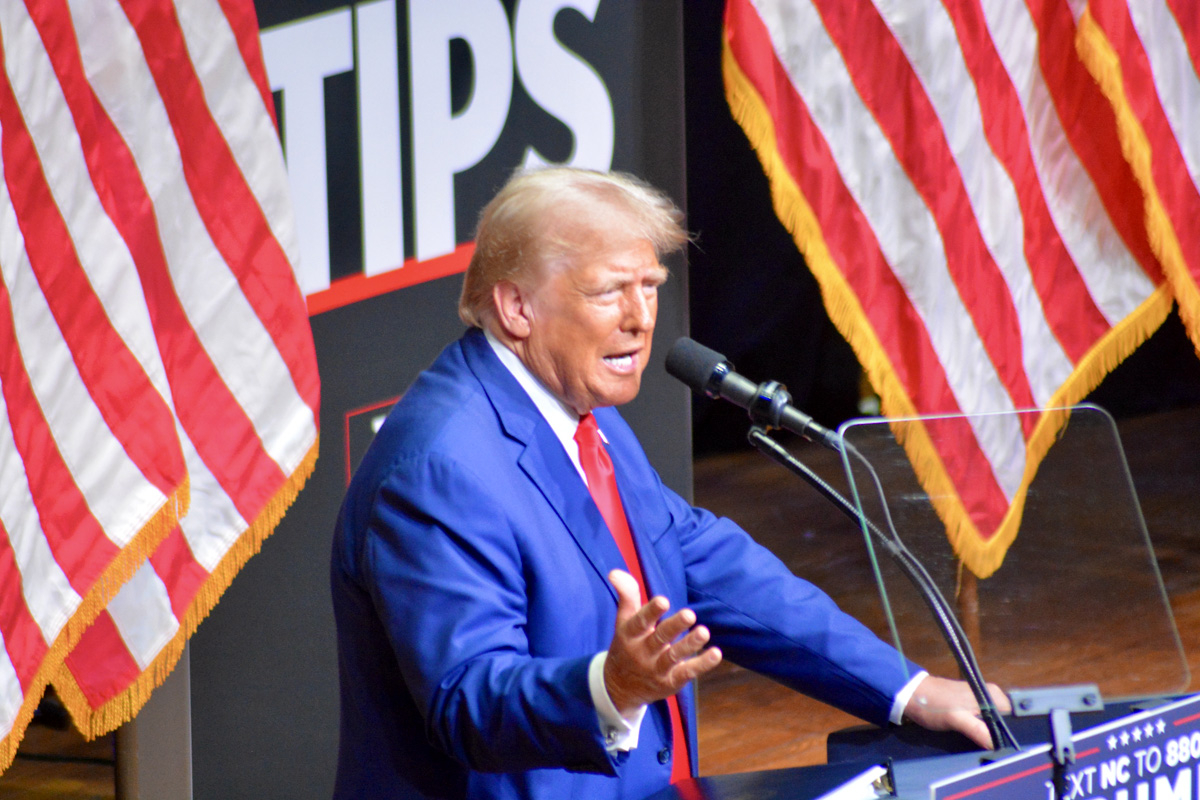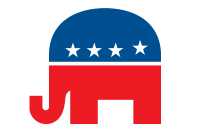Trump, light on policy but heavy on Harris attacks, visits Asheville
 Former President Donald Trump speaks at an event in Asheville on Aug. 14, 2024. Cory Vaillancourt photo
Former President Donald Trump speaks at an event in Asheville on Aug. 14, 2024. Cory Vaillancourt photo
At his Aug. 14 rally in Asheville — billed as an opportunity to deliver remarks on the economy — former President Donald Trump didn’t have much in the way of specifics, but he may have finally found his voice on the candidacy of Vice President Kamala Harris.
For weeks, Trump has struggled to message effectively against Harris, who became the Democratic nominee for President on Aug. 5, when duly elected Dem delegates selected her after five days of online balloting.
Although Trump did start in on President Joe Biden, the presumed Dem nominee until a disastrous debate performance prompted his departure from the ticket, his focus quickly shifted to Harris, whom he called “not very smart.” Trump mentioned Biden directly or indirectly 34 times but mentioned Harris at least 80 times.
“Everything Kamala Harris touches turns bad. It all turns bad. San Francisco was a great city. Now it’s unlivable,” Trump said. “California was a great state, now it’s unlivable. She breaks everything, just like she broke the border, broke our economy, but soon we are going to fix every single problem Kamala Harris and Joe Biden have created, and we are going to save our country.”
Harris may take some of the blame for San Francisco as the city’s district attorney from 2004 to 2011 and some of the blame for California as the state’s attorney general from 2011 to 2017, but Trump has complained about a broken border during and even before his lone term as president and has repeatedly mischaracterized Harris’ role as so-called “border czar.”
On the economy, the Dow’s initial 2.6% drop on Aug. 5, something he’d called the “Kamala crash,” had been largely erased by the time Trump took the stage in Asheville. Two days later, Barron’s reported that the S&P, Dow and NASDAQ were all “wrapping up what looks like [their] best week of the year.”
Related Items
The stock market, however, is not the full measure of the economy.
For July, the 12-month consumer price index — a key indicator of inflationary pressures on the economy — showed a 2.9% increase, the lowest such increase since March 2021. But for working families, that doesn’t erase the sting of year-over-year CPI increases above 7% during nearly every month of 2022.
“A lot of people are very devastated by what’s happened with inflation and all of the other things, so we’re doing this as a intellectual speech. You’re all intellectuals today,” Trump said, drawing laughs from the capacity crowd of nearly 2,050. “Today we’re doing it, and we’re doing it right now, and it’s very important.”
Trump railed on car insurance prices, which he said were up as much as 80%. That’s not quite accurate, but the 48% increase since 2021 as reported by Fox Business affects people with lower incomes more than it does the wealthy.
“We will target everything from car affordability to housing affordability to insurance costs to supply chain issues — we have the worst supply chain we’ve ever had in the history of the country — to the price of prescription drugs,” Trump continued. “I will instruct my cabinet that I expect results within the first 100 days, or much sooner than that. I would say the first seven days is fine.”
But he never said how; throughout Trump’s hour-long speech, there were more aspirational statements of desired outcomes — like lowering prescription drug prices — than there were solid policy points on how to achieve those outcomes.

Spectators lined Haywood Street in the hot sun before the event, waiting to get inside. Cory Vaillancourt photo
About the only topic on which Trump did offer specifics was energy costs, albeit with another misleading premise.
“We were energy independent four years ago,” he said. “Think of it.”
In the late 1950s, the United States briefly produced more energy than it consumed and exported more than it imported, according to the U.S. Energy Information Administration. The trend continued through the 1980s, when the gap began to widen substantially, peaking during the two terms of George W. Bush. The Obama years saw the gap close some, but the country still produced less energy than it consumed and imported more than it exported until 2019, when exports first topped imports in a meaningful way — a trend that has continued through all four years of the Biden administration.
Trump summed up his plan to end the “Biden-Harris war on a thing called American Energy” and slash energy prices by as much as 70% within 12 to 18 months by using a throwback shout-out to then-Alaska Gov. Sarah Palin’s “drill baby drill!” slogan from the 2008 campaign, during which she debated Biden on the subject.
“My administration will issue rapid approvals for new energy infrastructure, unlock new lands for drilling and achieve energy independence and energy dominance,” Trump said, noting that he would re-open drilling in the environmentally sensitive Arctic National Wildlife refuge in Alaska, something Biden ended in 2023.
“We’ll get it approved again very quick. And your prices are going to come tumbling down,” he said. “Your gasoline is going to come tumbling down in. Your heating bills and cooling bills are going to be coming down.”
Other goals of a second Trump term need little in the way of specifics because they’re relatively self-evident, even if their ultimate consequences aren’t.
Following first-term themes, Trump reiterated his desire to attack what he called a “regulatory onslaught,” called for the renewal of tax cuts skewed towards the wealthy and announced “the largest deportation operation in American history, starting at noon on Inauguration Day 2025.” Two large banners positioned on either side of Trump trumpeted new initiatives to eliminate taxes on tips and on social security.
Trump’s appearance was his second in the deep blue bastion of Asheville since 2016, following visits by Palin in 2008, Mitt Romney in 2012 and Harris in October 2020.
The crowd was noticeably smaller compared to the 7,000-seat venue he nearly filled in 2016 when he won the state by 3.66%.
Although he filled the room, by the end of the event many empty chairs were visible — likely attributable to many of the attendees standing for hours in the hot sun in a line that stretched from the Harrah’s Cherokee Center entrance down Haywood Street to Battery Park Avenue to the federal courthouse.
Trump again won North Carolina in 2020 by 1.34% in what became a losing effort to retain the presidency. The state is expected to be in play this year.













